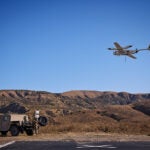
The Marine Corps is looking to modernize its signals intelligence (SIGINT) capability set with a new open architecture approach to go after capabilities that will allow users to better collect data while jamming adversaries’ improved assets, officials said Thursday. Officials told attendees at an Association of Old Crows Event the new approach is required to maintain overmatch as adversaries have made increasing investments over the last decade to maintain control over the electromagnetic spectrum. “One thing we’re doing right now…

 By
By 











